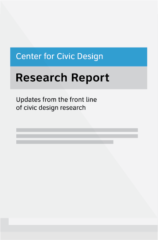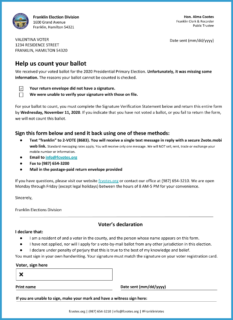Designing ballot cure forms that invite voters to act
Mail-in ballots can be rejected because of mistakes such as mismatched or missing signatures. Even when voters are given a chance to fix –or “cure” – the problem, they may not take advantage of the opportunity to have their ballot count.
We wanted to know why.
Does the communication style make a difference in motivating voters to take action? To find out, we tested examples of letters used by election offices.

Designing ballot cure forms that invite voters to act
Download reportKey findings
Here are 4 important things we learned.
Make it trustworthy
The first action a voter takes is to identify whether the communication 1) came from the election office and 2) is authentic. Adding a few universally recognizable elements to the form helps voters can know it is coming from a trusted, legitimate source. Including contact information for the election office also allowed for the form to feel more official.
“The form should have a [seal] on it to make it look more official. To me ‘official’ means having a [seal], letterhead, or something that identifies it with the BOE.”
Make it clear, avoiding jargon.
In addition to making the form trustworthy, voters have to understand what it tells them. Participants in our testing had strong, negative reactions to the word ‘cure,’ saying they had a hard time understanding how that concept applied to their ballots. When a word is interpreted with a negative meaning, it can be demotivating, as though voters are being told their ballot is sick.
“‘Cure’ is an interesting word choice. I assume it means to make it complete or countable. The connotation of it is usually medical.”
This also comes into play with phrases that are out of the everyday lexicon or understanding. Be as clear as possible to avoid confusion.
“I have no idea what they mean when they say ‘when the election is certified’. That is really vague.” (former poll worker)
Make it have a clear call to action
Finally, the letter and form need to provide a clear call-to-action to encourage voters to take the steps to cure their ballot.
Provide urgency in your opening statement without making them feel like they’re in trouble or they did something wrong. As an example, participants reacted well to “Help us count your ballot”.
Digital curing options, like email and mobile, will also allow more voters to access and feel motivated to fix their ballot, especially when deadlines are tight and for younger voters.
“[With the mobile option,] I’d be more inclined to act. I don’t need to leave my couch.”
Make the dates transparent.
Tight deadlines can make the curing process hard or impossible, which can frustrate voters. Consider adding a date stamp on the form, not only help the voter but, to provide accountability for the election office. In addition, give them clear, attainable deadlines so they feel they have a realistic time to act.
Putting the research to work
We created a simple mockup based on the aspects that the participants said were important. Use this as a checklist for your form to provide information voters need and, in turn, increase the overall response rate.
Use the header to make it trustworthy
- State or county seal or election logo (in color)
- Contact information
- Include phone #, email, website
- Point of contact name
(in header or closing) - Date sent
Explain the problem clearly
- Friendly, yet urgent first sentence
- Specific reason for receiving form
- Voter personalized address
- Clear, feasible deadlines
Tell them how to take action
- Multiple convenient options for ‘curing’
- Include mobile and email
- Bullet points or Steps
- Provide office address and hour
Show them where to sign
- Legal statement when necessary
- Area for signature, marked with an ‘x’
- Clear areas for dates or other information
About the research
This research was led by Maria Di Paolo with support from Alex Haraseyko, Asher Kolieboi, Christopher Patten, and Whitney Quesenbery.
We spoke with 8 participants from all over the US. We created 3 scenarios for different time frames in which a voter might receive a cure notice:
- Scenario 1: Let’s say you voted by mail three weeks early. One week later, you received something like this in the mail.
- Scenario 2: Say you still voted by mail about a week before the election but received something like this in the mail a few days later, on Thursday, October 29.
- Scenario 3: Say you still voted by mail, but you received something like this in the mail on Thu Nov 5, two days after the election.
For each scenario, participants viewed a packet of different variations of cure forms, with pages in randomized order.
The forms were based on a sample of real election materials using different styles. We replaced all identifying information with a fictitious location to prevent any inherent participant bias towards different places.
Related resources
Visit our page on voting by mail to find more resources about creating materials for every step of the vote by mail process.
Visit our page on voter education to find more resources about designing a range of materials that invite voters to participate.


